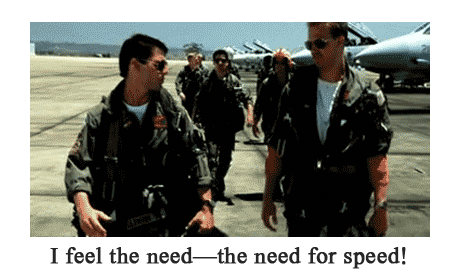- The Tempo
- Posts
- The Need for Speed - Volume 1
The Need for Speed - Volume 1
Coach Max Frankel's series on why triathletes NEED to train at higher intensities

Max Frankel is a former elite cyclist and collegiate runner and is currently a triathlete and coach based in Boulder, Colorado. Max is an accomplished coach in the marathon, track, and both short and long-course triathlon having coached multiple athletes to professional licenses in triathlon, wins at the marathon and ultramarathon distances, and numerous Boston Marathon, Ironman World Championship and 70.3 World Championship qualifiers.
If you’d like to inquire about his coaching, or have any questions/feedback on this new segment of The Tempo, feel free to drop Max an email at [email protected].
Maverick may have been talking about himself, but he might as well have been talking about the entire sport of triathlon.
Triathlon training needs a revolution, and it can’t come soon enough.
So many triathletes pride themselves on their ability to suffer for a very long time–even the cream of the crop of this newsletter’s readership takes over 7 hours to finish an Ironman–but that whole time, none of us are going truly HARD.
The suffering we feel comes as a result of how long we spend holding that effort, not the actual intensity of the effort itself relative to our threshold (FTP on the bike, 15k pace on the run, or all-out 1500m pace swimming).
With this in mind, many of us train at similar intensities to what we race: workouts are built out using terms like “Ironman pace” or “70.3 power.” But on a physiological level, these intensities are giving us the worst bang for our buck imaginable, especially for busy, time-crunched athletes who have to fit their training in with a multitude of other responsibilities (this method does work quite well when taken to the absolute extreme of 30+ hours of aerobic activity per week, ie The Norwegian Method, but I’m assuming not many of us are in that boat).
What we should look to instead are lessons that can be found in large magnitude across the independent forms of the three disciplines that we’re tasked with mastering.
Swimmers, cyclists, and runners everywhere incorporate very high-intensity training to improve at the middle intensities we race with in triathlon.
Before we go any further, I’d like to make clear that training at moderate intensity is not making you slower, it just simply might not be making you faster, and for 99% of triathletes it’s far from the most optimal method of improvement. The entire idea of optimization is the reason why we might hire a coach or spend time learning about performance on our own: to get the most bang for the hard-earned buck we spend out on the roads and in the water.
Why middle intensity is sub-optimal and why polarized training is more optimal will each be subjects of future segments and blog posts in The Tempo, but I’ll give a preview here:
“Middle intensity” is defined as the zone between LT1 and LT2, the two aerobic thresholds each athlete has for each sport (it can be argued that lactate zones don’t really exist in the pool, but we won’t get into that can of worms). Without going down a rabbit hole of lactate mumbo-jumbo,
Let’s define LT1 as slightly slower than marathon pace.
And LT2 as slightly slower than 10K pace (and similar effort levels on the bike).
Improvement to LT2 (which is what most people are referring to when they say “threshold”) is made up of improved low-end aerobic capacity and improved high-end aerobic capacity, or VO2–I hesitate to say “anaerobic” because the only true anaerobic efforts out there are those of 40 seconds or less.
Improving our low-end aerobic capacity happens at intensities under, or slower than, LT1–in this zone, we’re using only our slow-twitch muscle fibers, we’re burning mostly fat, and we aren’t accumulating more than a little bit of lactate in the blood. When we move into tempo/middle intensity, we’re now no longer purely aerobic–we’ve begun using some of our faster-twitch fibers, we’re burning some carbs as well as fat, and our lactate is no longer held at what essentially amounts to baseline.
Improving our high-end aerobic capacity is where misunderstanding becomes a significant issue. If zone 3, or tempo, is stressing the upper limits of our aerobic system, why does training in that zone not lead to a significant improvement to our high-end aerobic capacity? Well, as mentioned above, our high-end aerobic capacity (LT2) is made up of a pure aerobic component as well as a VO2 component, and training in zone 3, or between LT1 and LT2, is not stressing either of those two components. We are no longer making the same raw aerobic adaptations as we do at lower intensities, and we aren’t getting any of the truly high-end aerobic benefits that we get from training above our threshold.
By isolating these two branches of aerobic improvement to domains far on either side of what we’re looking to get better at (moderate intensity, 70.3, and Ironman pace/power), we can begin to see far more efficient improvements than just by hammering away at efforts that, while not hard to start, can certainly turn into a sufferfest after some time.
Be on the lookout for more discussion on polarized training and more in The Tempo with longer versions like this!
Reply